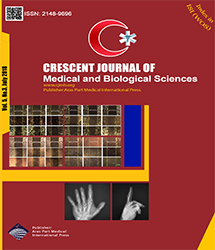
| Original Article | |
| Determining the Most Common Reproductive Health Needs of Rural Women of Reproductive Age, Iran, 2017 | |
| Khosheh Khaleghinezhad1, Nourossadat Kariman2, Fatemeh Nahidi3, Abbas Ebadi4, Malihe Nasiri5 | |
| 1Student Research Committee, Department of Midwifery and Reproductive Health, School of Nursing and Midwifery, Shahid Beheshti University of Medical Sciences, Tehran, Iran 2Midwifery and Reproductive Health Research Center, Department of Midwifery and Reproductive Health, Shahid Beheshti University of Medical Sciences, Tehran, Iran 3Department of Midwifery and Reproductive Health, Shahid Beheshti University of Medical Sciences, Tehran, Iran 4Behavioral Sciences Research Center, Life Style institute, Faculty of Nursing, Baqiyatallah University of Medical Sciences, Tehran, Iran 5Department of Biostatics, Faculty of Nursing and Midwifery, Shahid Beheshti University of Medical Sciences, Tehran, Iran |
|
|
CJMB 2018; 5: 176–180 Viewed : 27945 times Downloaded : 6367 times. Keywords : Needs assessment, Reproductive health, Rural women |
|
| Full Text(PDF) | Related Articles | |
| Abstract | |
Objectives: The frst step in designing a plan is need recognition. Given the fact that rural women are among the most deprived groups in terms of healthcare services, this study aimed to determine the most common reproductive health needs of rural women of reproductive age, which can provide the foundation for designing proper programs with regard to budget Materials and Methods: This cross-sectional study was conducted on rural women of reproductive age referred to rural healthcare centers of Neyshabur, Iran, during 2016-2017. In total, 405 subjects were selected through randomized sampling. The data collection tool was standardized questionnaire evaluating sexual and reproductive health needs. This instrument consists of seven sections, including background information, safe motherhood, family planning, sexual behaviors, sexually transmitted infections, HIV/AIDS, and physical and sexual violence. The answer to each question was categorized into 2 groups of favorable (Score 1 was given to it) and unfavorable (Score 2 was given to it), so low scores were indicative of favorable condition, whereas high scores reflected unfavorable status. Data analysis was performed using descriptive tests in SPSS version 17.0. Results: In this study, about half of the women were within the age range of 31-40 years, and 44.2% of them were illiterate or had low literacy levels. In addition, 84% of the subjects were housewives. Safe pregnancy domain had the most proper status (14.12±10.55), whereas HIV/AIDS domain was the least favorable condition (47.65±21.63). Conclusions: We recommend designing focused programs to improve the health of rural women in the domains of HIV/AIDS and sexually transmitted diseases (STDs), which are the most prioritized areas of reproductive health. |
Cite By, Google Scholar
Google Scholar
PubMed
Online Submission System
 CJMB ENDNOTE ® Style
CJMB ENDNOTE ® Style
 Tutorials
Tutorials
 Publication Charge
Medical and Biological Research Center
About Journal
Publication Charge
Medical and Biological Research Center
About Journal
Aras Part Medical International Press Editor-in-Chief
Arash Khaki
Deputy Editor
Zafer Akan


















